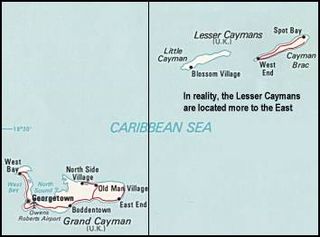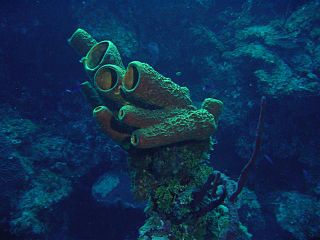
The CaymanIslands is a self-governing British Overseas Territory, and the largest by population. The 264-square-kilometre (102-square-mile) territory comprises the three islands of Grand Cayman, Cayman Brac and Little Cayman, which are located south of Cuba and north-east of Honduras, between Jamaica and Mexico's Yucatán Peninsula. The capital city is George Town on Grand Cayman, which is the most populous of the three islands.

The Cayman Islands are a British overseas territory located in the Caribbean that have been under various governments since their discovery by Europeans. Christopher Columbus sighted the Cayman Islands on May 10, 1503, and named them Las Tortugas after the numerous sea turtles seen swimming in the surrounding waters. Columbus had found the two smaller sister islands and it was these two islands that he named "Las Tortugas".

The Cayman Islands are a British dependency and island country. It is a three-island archipelago in the Caribbean Sea, consisting of Grand Cayman, Cayman Brac, and Little Cayman. Georgetown, the capital of the Cayman Islands is 438 km (272 mi) south of Havana, Cuba, and 504 km (313 mi) northwest of Kingston, Jamaica, northeast of Costa Rica, north of Panama and are between Cuba and Central America. Georgetown's geographic coordinates are 19.300° north, 81.383° west.
This is a demography of the population of the Cayman Islands including population density, ethnicity, religious affiliations and other aspects of the population.

The transport infrastructure of the Cayman Islands consists of a public road network, two seaports, and three airports.

Grand Cayman is the largest of the three Cayman Islands and the location of the territory's capital, George Town. In relation to the other two Cayman Islands, it is approximately 75 miles (121 km) southwest of Little Cayman and 90 miles (145 km) southwest of Cayman Brac.

Little Cayman is one of three Islands that make up the Cayman Islands. It is located in the Caribbean Sea, approximately 60 miles (96 km) northeast of East End, Grand Cayman and five miles (8 km) west of West End, Cayman Brac. Little Cayman is the least populous island of the three, with a permanent population of about 160 (2021) including seasonal residents/homeowners. The majority of the population are expatriate workers from Jamaica, the Philippines, and Honduras and from other Latin American countries as well as Canada, the USA, India, Australia, Scotland, England, and South Africa. There are a handful of local Caymanians estimated as fewer than 20. It is about 10 miles (16 km) long with an average width of 1 mile (1600 m) and most of the island is undeveloped. Almost the entire island is at sea level. The highest elevation is about 40 feet. The rainy season, which consists of mostly light showers, occurs in Mid-April until June and again in mid-September to mid-October. There will be occasional quick rain showers in the early morning hours. The coolest months are from End of November until Mid March as the cold fronts coming in from the North which the temperature can drop into the low'70s. The Hottest and dryest months are in Summer starting mid-June to mid-September with temperatures between the mid-80s and high 90s. There are no large or predatory or venomous animals that pose a threat to humans.

The three islands of the Cayman Islands are the exposed top of an underwater mountain. Underwater, the sides of this mountain are quite steep, vertical in some places, within as little as a few hundred metres from shore.

The flag of the Cayman Islands consists of a Blue Ensign defaced with the British overseas territory's coat of arms. Adopted in 1959 to supplement the Union Jack and to replace the flag of the Colony of Jamaica, it has been the flag of the Cayman Islands since the territory was granted self-government that year. The design of the present flag entailed removing the white disc and outlining the coat of arms with a white trim, although the previous version is often used in an official capacity. The Cayman Islands' flag is similar to the flags of eight other British Overseas Territories, which are also Blue Ensigns with their respective coats of arms.

George Town is the capital and largest city in the Cayman Islands, located on Grand Cayman. As of 2022, the city had a population of 40,957, making it the largest city of all the British Overseas Territories.

Cayman Brac is an island that is part of the Cayman Islands. It lies in the Caribbean Sea about 145 km (90 mi) north-east of Grand Cayman and 8 km (5.0 mi) east of Little Cayman. It is about 19 km (12 mi) long, with an average width of 2 km (1.2 mi). Its terrain is the most prominent of the three Cayman Islands due to "The Bluff", a limestone outcrop that rises steadily along the length of the island up to 43 m (141 ft) above sea level at the eastern end. The island is named after this prominent feature, as "brac" is a Gaelic name for a bluff.

.ky is the Internet country code top-level domain (ccTLD) for the Cayman Islands. The code was chosen as other possible options had already been allocated. Registration was limited to residents and registered companies in the Cayman Islands with a local address, but this restriction was removed in September 2015. The Cayman Islands also has the international three-letter code CYM and has won a bid to be awarded the .cym domain in a future expansion of the top-level domain space.

Sir Captain Charles Kirkconnell International Airport is an airport serving Cayman Brac, Cayman Islands. It is one of the hubs for Cayman Airways with flights to Owen Roberts International Airport on Grand Cayman, and Edward Bodden Airfield on Little Cayman. It is the only airport on Cayman Brac.
The culture of the Cayman Islands has been influenced by Afro-Caribbeans of Jamaica, colonists of Great Britain. In the 21st century, approximately 113 nationalities make up the residents on the three islands comprising the country. The total population of the Cayman Islands is 81,546 people spread throughout the island group, with the majority of the people found on Grand Cayman. Roughly 37,000 are generational Caymanians, with the remainder being immigrants, their children, and permanent residents.

Edward Bodden Airfield, also known as Little Cayman Airport, is an airfield on the southwest side of Little Cayman, one of the Cayman Islands.

Cyclura nubila caymanensis, the Lesser Caymans iguana, Cayman Brac iguana, Cayman Island brown iguana or Sister Isles iguana, is a critically endangered subspecies of the Cuban iguana. It is native to two islands to the south of Cuba: Cayman Brac and Little Cayman, which are also known as the Sister Isles due to their similar shapes and close proximity to each other. The population of this subspecies has been impacted by habitat encroachment by human development and is likely being destroyed due to predation by cats, the population on Cayman Brac has remained particularly small for decades.

Hurricane Paloma was a strong late-season tropical cyclone that set several records for its intensity and formation. It was the sixteenth tropical storm, eighth hurricane and fifth major hurricane of the 2008 Atlantic hurricane season. Paloma was, at the time, the third most powerful November hurricane on record in the Atlantic Basin, behind only the 1932 Cuba hurricane, 2020's hurricanes Iota and Eta, and a tie of 1999's Hurricane Lenny, and 2001's Hurricane Michelle. Paloma also marked the first time that at least one major hurricane formed in every month of the hurricane season from July to November, with only June not having a major hurricane in the season.
The Stella Maris Church is a Catholic church which is located in Alta Vista Drive on the island of Cayman Brac about 143 kilometers from the main island of the Cayman Islands, a British overseas territory in the Caribbean Sea.













